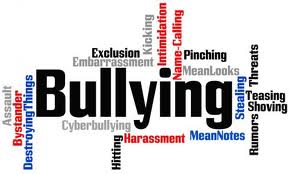Stop Bullying!
Bullying is something we take very seriously. We recognize students have varying levels of social skills and often students who bully others are doing it to achieve something, often peer attention. Unfortunately, this is a negative way to gain peer attention. Along with creating a safe environment at school, we work very hard to help students develop appropriate social skills. We believe we have an obligation to help all students grow not only academically, but also emotionally and socially. Our guidance curriculum supports students in better understanding bullying and how to respond.
The roles kids play in bullying are not limited to those who bully others and those who are bullied. Some researchers talk about the “circle of bullying” to define both those directly involved in bullying and those who actively or passively assist the behavior or defend against it. Direct roles include:
- Kids who Bully: These children engage in bullying behavior towards their peers. There are many risk factors that may contribute to the child’s involvement in the behavior. Often, these students require support to change their behavior and address any other challenges that may be influencing their behavior.
- Kids who are Bullied: These children are the targets of bullying behavior. Some factors put children at more risk of being bullied, but not all children with these characteristics will be bullied. Sometimes, these children may need help learning how to respond to bullying.
Even if a child is not directly involved in bullying, they may be contributing to the behavior. Witnessing the behavior may also affect the child, so it is important for them to learn what they should do when they see bullying happen. Roles kids play when they witness bullying include:
- Kids who Assist: These children may not start the bullying or lead in the bullying behavior, but serve as an “assistant” to children who are bullying. These children may encourage the bullying behavior and occasionally join in.
- Kids who Reinforce: These children are not directly involved in the bullying behavior but they give the bullying an audience. They will often laugh or provide support for the children who are engaging in bullying. This may encourage the bullying to continue.
- Outsiders: These children remain separate from the bullying situation. They neither reinforce the bullying behavior nor defend the child being bullied. Some may watch what is going on but do not provide feedback about the situation to show they are on anyone’s side. Even so, providing an audience may encourage the bullying behavior.
- Kids who Defend: These children actively comfort the child being bullied and may come to the child’s defense when bullying occurs.
Most kids play more than one role in bullying over time. In some cases, they may be directly involved in bullying as the one bullying others or being bullied and in others they may witness bullying and play an assisting or defending role. Every situation is different.
A great resource to learn more about bullying is: www.stopbullying.gov
Please always visit with your child’s teacher, or our school counselor, if you have questions.

